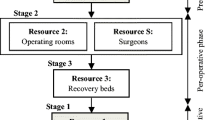Abstract
We study a problem arising from surgical operations scheduling and model it as a resource-constrained machine scheduling problem with machine eligibility restriction to minimize the makespan. By decomposing the problem into two sub-problems, we develop effective heuristic algorithms to solve the problem. We test the proposed algorithms on randomly generated instances as well as real data set from a large hospital. The numerical results show the effectiveness and potential practical value of the models and the algorithms.

Similar content being viewed by others
Notes
The performance measure is calculated by \(\left( \dfrac{(Value\; of\; the\; Algorithm)}{(Optimal\; Value)}-1\right) \). However, getting optimal values for some instances are too time-consuming, hence for such data groups we use near optimal values with 8 % relative gap. We then use \(\left( \dfrac{(Value\; of\; the\; Algorithm)*1.08}{(Near\; Optimal\; Value)}-1\right) \) to calculate the APG/WPG. The APG/WPG of the data groups with mark * are calculated in this way in Table 4.
References
Beliën J, Demeulemeester E (2008) A branch-and-price approach for integrating nurse and surgery scheduling. Eur J Oper Res 189:652–668
Blake JT, Carter MW (2002) A goal programming approach to strategic resource allocation in acute care hospitals. Eur J Oper Res 140:541–561
Cardoen B, Demeulemeester E, Beliën J (2009) Sequencing surgical cases in a day-care environment: an exact branch-and-price approach. Comput Oper Res 36:2660–2669
Fei H, Meskens N, Chu C (2010) A planning and scheduling problem for an operating theatre using an open scheduling strategy. Comput Ind Eng 58:221–230
Ge D, Wan G, Wang Z, Zhang J (2014) A note on appointment scheduling with piecewise linear cost functions. Math Oper Res 39:1244–1251
Gerchak Y, Gupta D, Henig M (1996) Reservation planning for elective surgery under uncertain demand for emergency surgery. Manage Sci 42:321–334
Glass CA, Kellerer H (2007) Parallel machine scheduling with job assignment restrictions. Naval Res Logist 54:250–257
Guerriero F, Guido R (2011) Operational research in the management of the operating theatre: a survey. Health Care Manag Sci 14:89–114
Guinet A, Chaabane S (2003) Operating theatre planning. Int J Prod Econ 85:69–81
Jebali A, Hadj Alouane AB, Ladet P (2006) Operating rooms scheduling. Int J Prod Econ 99:52–62
van der Lans M, Hans EW, Hurink JL, Wullink G, van Houdenhoven M, Kazemier G (2006) Anticipating urgent surgery in operating room departments. Tech Rep., BETA working paper WP-158
Magerlein JM, Martin JB (1978) Surgical demand scheduling: a review. Health Serv Res 13:418
May JH, Spangler WE, Strum DP, Vargas LG (2011) The surgical scheduling problem: current research and future opportunities. Prod Oper Manag 20:392–405
Meskens N, Duvivier D, Hanset A (2013) Multi-objective operating room scheduling considering desiderata of the surgical team. Decis Support Syst 55:650–659
Min D, Yih Y (2010) An elective surgery scheduling problem considering patient priority. Comput Oper Res 37:1091–1099
Ou J, Leung JYT, Li CL (2008) Scheduling parallel machines with inclusive processing set restrictions. Naval Res Logist 55:328–338
Pham DN, Klinkert A (2008) Surgical case scheduling as a generalized job shop scheduling problem. Eur J Oper Res 185:1011–1025
Pinedo ML (2012) Scheduling: theory, algorithms, and systems. Springer, New York
Shchepin EV, Vakhania N (2005) An optimal rounding gives a better approximation for scheduling unrelated machines. Oper Res Lett 33:127–133
Smith-Daniels VL, Schweikhart SB, Smith-Daniels DE (1988) Capacity management in health care services: Review and future research directions. Decis Sci 19:889–919
Stahl JE, Sandberg WS, Daily B, Wiklund R, Egan MT, Goldman JM, Isaacson KB, Gazelle S, Rattner DW (2006) Reorganizing patient care and workflow in the operating room: a cost-effectiveness study. Surgery 139:717–728
Strum DP, May JH, Vargas LG (2000) Modeling the uncertainty of surgical procedure times: comparison of log-normal and normal models. Anesthesiology 92:1160–1167
Strum DP, Vargas LG, May JH (1999) Surgical subspecialty block utilization and capacity planning: a minimal cost analysis model. Anesthesiology 90:1176–1185
Testi A, Tanfani E, Torre G (2007) A three-phase approach for operating theatre schedules. Health Care Manag Sci 10:163–172
Vairaktarakis GL, Cai X (2003) The value of processing flexibility in multipurpose machines. IIE trans 35:763–774
Wang Y, Tang J, Pan Z, Yan C (2014) Particle swarm optimization-based planning and scheduling for a laminar-flow operating room with downstream resources. Soft Comput. doi:10.1007/s00500-014-1453-z
Wright IH, Kooperberg C, Bonar BA, Bashein G (1996) Statistical modeling to predict elective surgery time: comparison with a computer scheduling system and surgeon-provided estimates. Anesthesiology 85:1235–1245
Zhao Z, Li X (2014) Scheduling elective surgeries with sequence-dependent setup times to multiple operating rooms using constraint programming. Oper Res Health Care 3:160–167
Zhong L, Luo S, Wu L, Xu L, Yang J, Tang G (2014) A two-stage approach for surgery scheduling. J Comb Optim 27:545–556
Acknowledgments
The research is supported in part by National Science Foundation of China (Grants 71125003 and 71421002).
Author information
Authors and Affiliations
Corresponding author
Rights and permissions
About this article
Cite this article
Wang, S., Su, H. & Wan, G. Resource-constrained machine scheduling with machine eligibility restriction and its applications to surgical operations scheduling. J Comb Optim 30, 982–995 (2015). https://doi.org/10.1007/s10878-015-9860-3
Published:
Issue Date:
DOI: https://doi.org/10.1007/s10878-015-9860-3




